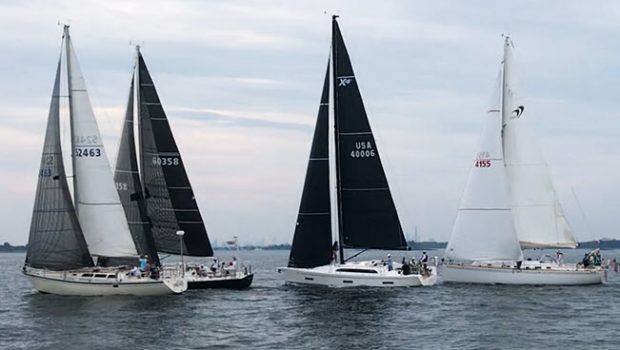Speed always makes you look smarter
Published on June 19th, 2020
On the inland lakes, the wind direction and pressure can get whacky, but with dinghies that maneuver well, it’s possible to adjust to the changes. UK Sailmakers’ Adam Loory reminds us the same approach succeeds in bigger keelboats too:
During a Thursday night race we had a southwestly, which is the predominant breeze on western Long Island Sound. On top of the normal breeze, we were faced with an outgoing tide, meaning the first leg was a beat against the current. In these conditions, there are two schools of thought on how to get to the windward mark.
The first is to play the left side of the beat, sailing off on starboard until you get close enough to the Long Island shore to get knocked. That’s when you tack to port and, hopefully, get the lift as the wind squares up coming off the land.
The second approach is to tack to port soon after starting and play the right side of the course between the Westchester shore and Execution Rocks lighthouse. The right side of the course has less adverse current.
Playing the middle of the beat is not an option since there is an island, a lighthouse, and a reef in the middle of the beat! It’s a “pick your poison” decision.
We saw more wind to the left and headed to the Long Island Shore right off the line alongside the J/112e REVIVER. They were pointing well and worked out to a position 5-6 boatlengths to windward of us. When we thought we had crossed the shipping channel and its strong adverse current, we tacked earlier than normal. That way, if REVIVER tacked on us, we would have room to take away.
When it was clear that we tacked early and were not getting the shore lift, we tacked back to starboard. Once we got as close to the shore as close as we dared, we tacked back to port. At this point we had lost a bit of ground to REVIVER, which had only tacked once, but we were up on their windward hip.
As we sailed on port, now the favored tack to the mark, we both got lifted and we wound inside of REVIVER. As we sailed, the wind started retreating toward the Long Island shore. Even though the wind retreated away from REVIVER, now a few lanes to leeward of us, we were still in the wind. She didn’t tack and we sailed over her.
About one-quarter mile from the mark, the wind retreated more and left us ghosting at three knots. Gerard Girstl, who was doublehanding with me, saw this happening and suggested we tack away from the mark and sail up to where there was wind.
At first, I resisted because we were making the mark, but when the speed dropped to three knots from seven, it was time to get back into the breeze.
We only had to sail about five boatlengths on starboard before we got back into the breeze. We tacked, and even though we had overstood, we reached into the mark at seven knots. REVIVER, which didn’t tack, dropped to third and rounded at least three minutes behind us.
The moral of this story is all about pressure! When given the choice of sailing the most direct course or sailing with wind, always go for the wind. Speed always makes you look smart!









 We’ll keep your information safe.
We’ll keep your information safe.